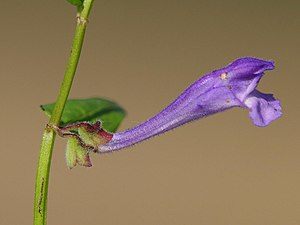Skewer skullcap
| Skewer skullcap | ||||||||||||
|---|---|---|---|---|---|---|---|---|---|---|---|---|

Skewer skullcap ( Scutellaria hastifolia ) |
||||||||||||
| Systematics | ||||||||||||
|
||||||||||||
| Scientific name | ||||||||||||
| Scutellaria hastifolia | ||||||||||||
| L. |
The spit skullcap ( Scutellaria hastifolia ), also Spießblättriges skullcap called, is a species of the genus Scutellaria ( Scutellaria ) within the family of Labiatae (Lamiaceae).
description
Appearance and leaf
The spit skullcap is a deciduous, perennial herbaceous plant that usually reaches heights of 15 to 40 (5 to 50) centimeters. It forms a rhizome as a permanent organ. The ascending to more or less upright stem , square in cross section, is unbranched or branched and almost bald to sparsely hairy.
The constantly against arranged on the stem leaves are divided into petiole and leaf blade. The petiole is up to 1/4 as long as the leaf blade . The simple leaf blade is usually 15 to 25 (8 to 40) millimeters long and usually 5 to 12 (4 to 20) millimeters wide and lanceolate to ovoid, at least in the tip half with entire margins or sometimes with one to three small notches in the base half. The base of the blades is rounded or truncated, rarely almost heart-shaped or blunt; in the middle leaves it is clearly spike-shaped, sometimes a blunt serrated tooth is present above the spit corners. The leaf surfaces are more or less bare.
blossom
The flowers are in distant or dense axillary pairs and heaped at the end of the stem to form one-sided false spikes. The short glandular hairy bracts resemble the true leaves, however, are almost sitting and shorter than the flowers and the upper bracts are trimmed at the bottom.
The flowering time is at the end of early summer. The hermaphrodite flowers are zygomorphic with a double flower envelope . The glandular-downy hairy calyx is 3 to 4 millimeters long and two-lipped. The short, hairy, violet-blue crown is usually 15 to 20 (10 to 23) millimeters long and two-lipped. The corolla tube is bent by about 70 °. The stamens are parallel.
Chromosome number
The number of chromosomes is 2n = 32.
ecology
The skullcap is a mesomorphic, helomorphic hemicryptophyte .
The pollination is done by insects . The diaspores spread through wind spread, Velcro spread or self-spread.
Occurrence
The skullcap is found in large parts of Europe, but is absent in the southwest and the far north, as well as the islands. The main distribution area of the skullcap is in south-eastern Europe , but extends to the Caucasus. In Central Europe it is rarely found on the lower Weser and the Lower Elbe ; it is occasionally found on the Rhine between the mouths of the Neckar and Main , on the Danube below Regensburg and at the southern foot of the Alps . It occurs sparsely in the regions outside the Alps in Austria .
The skullcap thrives best on wet, nitrogen-rich , not too solidified, muddy - peaty clay soils in the floodplain of rivers. It inhabits banks and ditches. It grows in damp grasslands . It occurs mainly in the Veronico longifoliae-Euphorbietum palustris from the association of perennial vegetation of wet locations (Filipendulion), but is also found in associations of the burnt umbel meadows (association Cnidion dubii).
swell
Individual evidence
- ↑ a b c d e f g h i Spit-leaved skullcap. In: FloraWeb.de.
- ↑ a b c d e TG Tutin, VH Heywood, NA Burges, DM Moore, DH Valentine, SM Walters, DA Webb (eds.): Flora Europaea . Volume 3: Diapensiaceae to Myoporaceae . Cambridge University Press, Cambridge 1972, ISBN 0-521-08489-X , pp. 137 (English, limited preview in Google Book search).
- ↑ a b Erich Oberdorfer : Plant-sociological excursion flora for Germany and neighboring areas . With the collaboration of Angelika Schwabe and Theo Müller. 8th, heavily revised and expanded edition. Eugen Ulmer, Stuttgart (Hohenheim) 2001, ISBN 3-8001-3131-5 , pp. 796-797 .
- ↑ a b c d Dietmar Aichele, Heinz-Werner Schwegler: The flowering plants of Central Europe . 2nd Edition. tape 4 : Nightshade plants to daisy plants . Franckh-Kosmos, Stuttgart 2000, ISBN 3-440-08048-X .
- ↑ Rafaël Govaerts (ed.): Scutellaria hastifolia. In: World Checklist of Selected Plant Families (WCSP) - The Board of Trustees of the Royal Botanic Gardens, Kew . Retrieved January 21, 2018.
Web links
- Scutellaria hastifolia L., Scutellated skullcap. In: FloraWeb.de.
- Skewer skullcap . In: BiolFlor, the database of biological-ecological characteristics of the flora of Germany.
- Distribution in the northern hemisphere
- Thomas Meyer: Skullcap data sheet with identification key and photos at Flora-de: Flora von Deutschland (old name of the website: Flowers in Swabia )
- Data sheet with photos.
- Data sheet with photos.



